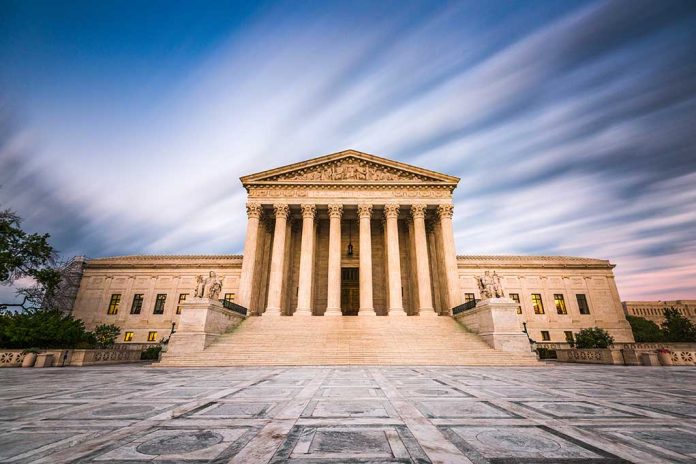
President Trump’s push for authority to fire independent agency heads awaits a pivotal Supreme Court ruling that could dramatically reshape federal government power dynamics.
Key Takeaways
- The Trump administration has asked the Supreme Court to grant presidential power to remove independent regulators, potentially affecting agencies like the Federal Reserve Board.
- The cases involve two Biden appointees—Gwynne Wilcox of the National Labor Relations Board and Cathy Harris of the Merit Systems Protection Board—whom Trump removed but lower courts reinstated.
- A 90-year-old precedent established in Humphrey’s Executor v. U.S. (1935) currently protects independent agency leaders from presidential removal without cause.
- If successful, Trump’s legal challenge could dramatically expand White House control over regulatory bodies that impact economic policy, consumer protection, and communications.
- The administration argues that forcing presidents to delegate executive power to agency heads opposing their policy objectives is “untenable” and unconstitutional.
Challenge to a 90-Year Precedent
The Trump administration has taken its fight to expand presidential powers to the Supreme Court, seeking authority to remove leaders of independent regulatory agencies who oppose administration policies. This effort directly challenges a longstanding legal precedent dating back to 1935, when the Supreme Court ruled in Humphrey’s Executor v. U.S. that Congress could shield certain agency officials from presidential removal. The case represents a critical test of constitutional boundaries between presidential authority and the independence of regulatory bodies that shape American life.
“This situation is untenable, The President should not be forced to delegate his executive power to agency heads who are demonstrably at odds with the Administration’s policy objectives for a single day — much less for the months,” said Solicitor General D. John Sauer.
The legal dispute centers on President Trump’s removal of two Biden-appointed officials—Gwynne Wilcox from the National Labor Relations Board and Cathy Harris from the Merit Systems Protection Board. Both officials were reinstated by lower courts, but the administration has escalated the matter to the nation’s highest court, arguing that laws protecting these positions from presidential removal without cause violate the Constitution’s separation of powers.
Trump asks Supreme Court to let him fire independent regulators https://t.co/u44Z8Fty6i
— @AcrossTheCurve (@acrossthecurve) April 9, 2025
The “Unitary Executive” Theory Takes Center Stage
President Trump’s legal challenge builds on the “unitary executive” theory, which holds that the Constitution grants presidents complete control over executive branch functions. Administration lawyers argue that independent agencies exercise executive power but escape appropriate presidential oversight, creating an unconstitutional arrangement. This perspective has gained traction with the Court’s conservative majority in recent years, signaling potential receptiveness to Trump’s argument.
The Supreme Court has already shown willingness to reconsider the structure of independent agencies. In 2020, the Court ruled in Seila Law LLC v. Consumer Financial Protection Bureau that the CFPB’s single-director structure was unconstitutional, though it stopped short of overturning Humphrey’s Executor entirely. Several justices, however, expressed interest in revisiting the broader question of independent agency constitutionality, setting the stage for the current challenge.
Potential Consequences for Federal Governance
Should the Supreme Court rule in President Trump’s favor, the decision would fundamentally alter the regulatory landscape in Washington. Agencies designed to operate independently from political pressure—including the Federal Reserve Board, Federal Trade Commission, and Federal Communications Commission—could become directly accountable to White House directives. Critics fear this would inject political considerations into technical regulatory decisions affecting financial markets, consumer protection, and communications policy.
“it would be a real earthquake in terms of the way our government operates. All these agencies that people may not think about have a real impact on people’s day-to-day lives,” Brianne Gorod said.
The Trump administration counters that the current system permits entrenched bureaucrats to thwart democratically elected presidents’ policy agendas. Administration officials have signaled interest in replacing agency leaders with business-friendly figures committed to reducing regulatory burdens. This approach aligns with President Trump’s broader economic vision of streamlining government oversight to promote economic growth and job creation.
Supreme Court’s Pivotal Role
The Supreme Court’s decision will significantly impact not just the balance of power between the president and Congress but also the fundamental operation of the federal government. Justice Elena Kagan previously warned against undermining administrative independence in her Seila Law dissent, highlighting the specialized expertise these agencies provide. The Court must now weigh these considerations against the constitutional arguments for presidential control of all executive functions.
As the justices deliberate, both supporters and critics recognize the potentially transformative implications of this case. A ruling in Trump’s favor would represent one of the most significant expansions of presidential authority in decades, while preserving the status quo would maintain longstanding boundaries on executive power. Either outcome will shape the relationship between the White House and federal agencies for generations to come.
Sources:
- Trump asks Supreme Court to let him fire independent regulators | Constitutional Accountability Center
- Supreme Court expected to consider giving Trump more firing power, overruling 90-year-old precedent | AllSides
- A 90-year precedent in danger: How Trump could gain unprecedented firing powers






